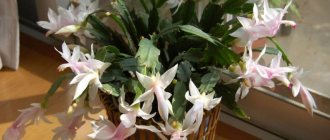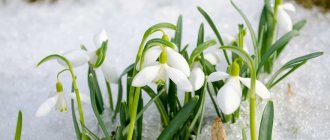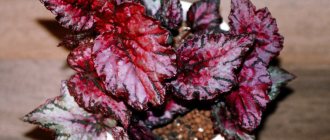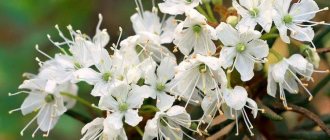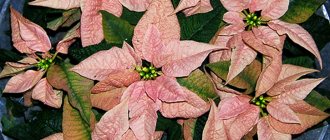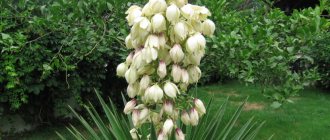Author: Elena N. https://floristics.info/ru/index.php?option=com_contact&view=contact&id=19 Category: Garden plants Published: June 22, 2018Last edits: November 05, 2020
- Growing conditions
- Diseases and their treatment
- Alpine snowdrop (Galanthus alpinus = Galanthus schaoricus)
Snowdrop, or galanthus (lat. Galanthus) is a genus of herbaceous perennials of the Amaryllis family, which includes 18 species and two natural hybrids. The scientific name of the genus is translated from ancient Greek as milky-flowered and characterizes the color of the flowers of the plant. To the English, galanthus is known as “snow earring” or “snow drop”, to the Germans as “snow bell”, and in our country it is called “snowdrop” for its early appearance on soil that is still dead after winter - literally “from under the snow”. The largest number of species of this plant (16) can be found in the Caucasus, and 6 of them are listed in the Red Book because they are endangered. Many types of snowdrops are grown as ornamental plants, and they were introduced into cultivation a very long time ago. For example, the terry form Flore Pleno has been known since 1731. There are many wonderful legends about snowdrops. One of them tells that on the day when Adam and Eve left Eden, it was snowing, and frozen Eve cried, and the Creator, to console her, turned several snowflakes into the very first flowers on Earth - snowdrops.
General information
Snowdrops, photos of which are presented in our material, are herbaceous perennials. Their scientific name is galanthus, which translated from ancient Greek means “milky-flowered.” They belong to the amaryllis family. There are at least 18 species in total, not counting hybrids.
Because of their delicate color, in England the flowers have the poetic name “snow catkins”, and in Germany – “snow bells”. The name given to snowdrops in Russia is due to the fact that they appear very early, even before the snow has completely melted.
Snowdrops are listed in the Red Book because they are at risk of extinction. However, they have received great recognition as ornamental plants. Flower growers grow them in gardens. Terry forms are extremely popular.
There are many legends about snowdrops. According to one of them, these flowers appeared on Earth a very, very long time ago. This happened when Adam and Eve left Eden. It is snowing. Eva, frozen, began to cry. To console her, the Creator turned several snowflakes into delicate flowers.
Low-resistant and rare species, many of which are listed in the Red Book
Snowdrop angustifolius / Galanthus angustifolius
Snowdrop or galanthus: description and care
Snowdrop angustifolia is endemic to Russia, grows in nature in the regions of Central and Eastern Ciscaucasia, is listed in the Red Book and is protected in two reserves of the North Ossetian and Kabardino-Balkarian Republics.
The narrow-leaved species is one of the smallest snowdrops and is characterized by slow growth.
Snowdrop angustifolia
Caucasian snowdrop, Caucasian galanthus / Galanthus caucasicus
Caucasian snowdrop is a rare species with a limited range: endemic to the Caucasus. Suffers from massive flower picking and digging. It is successfully grown in 8 botanical gardens of the Russian Federation.
The species is distinguished by a rather high peduncle - 20 cm high. The leaves have two flat leaves covered with a waxy coating. The flowers are white, medium in size, up to 3 cm long.
Caucasian snowdrop
It blooms in the first half of April, for two weeks.
Propagated vegetatively and by seeds. The species is moderately resistant in cultivation and does not tolerate frost well.
Kabardian snowdrop is included in the Red Book of the Chechen Republic.
Plant up to 7–15 cm tall. The flowers are medium-sized - up to 3 cm long.
Blooms in early April. Reproduces vegetatively.
The species is quite stable, but rare in culture.
Kabardian snowdrop
Greek snowdrop, Greek galanthus / Galanthus graecus
The Greek snowdrop is rare in our country; it is a medium-resistant species, native to the mountains of Asia Minor.
Peduncles up to 10 cm high; there are green spots at the base of the inner perianth lobes. Blooms in early April.
Reproduces vegetatively.
Icarian snowdrop, Galanthus ikariae
The species is similar to Voronov's snowdrop, native to Asia Minor, an island in the Aegean Sea. Not stable in middle zone culture.
The plants are small, the flowers are 2–2.5 cm long. There are green spots at the ends of the inner perianth segments.
Snowdrop icarian
Description
Snowdrops tend to grow in large groups. At first, the flowers stretch towards the sun, but over time the buds bend and the peduncle bends bizarrely. They are shaped like bells. The snowdrop flower, the description of which you are now reading, looks like a drop of snow. This feature was noted by the British.
The plant has two dark green leaves. They appear simultaneously with flower stalks. Their length is on average 10 cm. The bract consists of two halves. Its function is to protect the bud. On the peduncle there is one snow-white bud formed by six delicate petals. Three of them are in the inner row, and the remaining ones surround them. The flowering period lasts 2 weeks. Flowers disappear after the snow melts.
Feeding
Perennial garden primrose
While the snowdrop is actively growing, it needs liquid fertilizing with inorganic potassium phosphate fertilizers without nitrogen, which can cause excessive leaf growth. Potassium is needed for the formation of healthy winter-hardy bulbs, and phosphorus is necessary for flowering. Active growth requires a lot of water. Usually watering is not needed, but if suddenly the spring is dry, then the grower will have to provide the plant with moisture. Watering small bulbous plants is not burdensome - they are very resistant to drought and will not die, but will not be tall. No maintenance is required until the end of the season.
So, easy care of the unpretentious plant will bring joy to gardeners and preserve the snowdrop. The Red Book is needed as a document that controls its protection.
Caucasian snowdrop is a type of bulbous plant that is listed in the Red Book and is carefully protected by the state. The appearance of the first snowdrops from under the snow indicates the imminent approach of spring.
Caucasian snowdrop is a rare plant species that lives mainly in Russia. It got its name because it grows literally from under the snow in early spring. Snowdrops are found in groups, where they grow and form clearings. He is comfortable in wooded areas in loose humus soil. Requires cold for bud formation. The snowdrop is listed in the Red Book, since the total number does not exceed 200 thousand individuals. The plant especially suffers due to improper harvesting for commercial purposes.
Description of the plant
Snowdrop is a perennial plant of the bulbous family. The growing season directly depends on the latitude and climate of its habitat. The first flowers may appear in both February and April. The snowdrop bulb is no more than 3 cm in size and consists of last year's segment and a new bulb. And a new plant will subsequently grow from it. Wide leaves emerge from the bulb, usually two or three of them. At the same time, buds appear, which, after changing from cold to warm, release a small inflorescence. The color of the flowers of the Caucasian species of snowdrops can be either white or with bright green spots. The peduncle is cylindrical, slightly flattened at the edges. The flower's head always looks down. Reproduction occurs by seeds and vegetative methods. Seeds that fall out of the capsule are carried by ants. Pollination occurs through the efforts of flying insects.
Measures taken to increase plant numbers:
- A complete ban on the collection and distribution of snowdrops.
- Careful monitoring of the plant's annual population.
- Promotion of snowdrop cultivation on individual specialized farms for further implementation.
- Protection of plant habitats.
If you follow the rules for growing snowdrops, you can plant them in your local area. The main thing is not to disturb the bulb, which needs moisture during the period of active growth, and also periodically feed it with fertilizers.
Benefits and harms
Snowdrops (you can find a photo of the plant in our article) are medicinal plants and are widely used in folk medicine. However, an incredibly useful culture can be extremely dangerous. The fact is that flowers contain a large amount of toxic substances and alkaloids, which in certain quantities can cause poisoning. In small doses, snowdrops are added to medicines that are intended to combat various diseases. Now let’s list the most popular types of snowdrops.
Alpine
This plant is cultivated in gardens and summer cottages. However, sometimes alpine snowdrops, photos of which evoke only pleasant impressions, are also found in the wild. Flowering begins in the fourth year after planting. This species has long, rich green leaves and neat white bell-shaped buds. The leaves are broadly lanceolate, their length reaches 7 cm. The stem is short, only 7-9 cm in height. Flowers appear in spring. At the end of the flowering period, seed boxes appear. With their help you can propagate plants.
Photo of white snowdrops
You can admire the carpet of white inflorescences in a painting, but it is much more pleasant to grow such plants in the garden. Seeds collected with your own hands or bulbs purchased in a specialized store are suitable for this.
Figure 7. Photo of white spring flowers
The value of plants is preserved only if they are in a flower bed. If you pick these flowers, the bouquet will last no longer than a few days, whereas in the garden they can delight you for a month.
Byzantine
This variety of snowdrops was first discovered on the coast of the Bosphorus Strait. This plant is successfully cultivated not only in Asia, but also in European countries, but in Russia it is not very popular. The variety has an amazing feature. While most snowdrops appear before the snow melts and herald spring, representatives of the Byzantine variety bloom in the autumn season. The appearance of the plant is also unusual: the inflorescence is white and carved, with long snow-white petals located around it.
Caucasian
In addition to white ones, there are also blue snowdrops. White is the standard color for this plant. As for the Caucasian variety, it has a peculiarity: there are small green inclusions on the white petals.
The plant is most often found in the central part of the Caucasus. It has long, narrow leaves. Flowering lasts from early to mid-March. Fruiting, however, is irregular. If you are going to grow Caucasian snowdrops at home, take care to create a shelter for the winter.
Snow-white
In Russia, this variety of snowdrops is the most popular. Photos with these flowers turn out very beautiful. Representatives of this variety have long narrow leaves and rather large inflorescences, reaching a diameter of 3 cm.
This variety grows quickly. It does not require careful care, so it is often cultivated in summer cottages. In a few years it will spread throughout the entire garden bed. The peculiarity of this variety is the early onset of flowering. The buds appear at the very beginning of March and delight the eye with their beauty until the end of the month, that is, flowering lasts approximately 25-30 days.
folded
This variety of snowdrops is one of the most beautiful. It has a number of external features. Firstly, the plant reaches a height of 25 cm, which is uncharacteristic for these flowers. In addition, its inflorescences are very large, their diameter is about 40 cm.
The folded snowdrop is found in Ukraine, Moldova and Romania. However, it is also successfully grown in gardens. When do snowdrops of this variety bloom? In the beginning of March. The buds remain attractive for 14-20 days, after which they fade. This culture is highly decorative. It grows quickly and within a few seasons after planting it occupies vast areas, like a flower carpet.
Varietal diversity
You can buy 50 types of snowdrop bulbs. They bloom early and last a long time pleasing the eye. This usually lasts for a period of 30 days. The following varieties of culture are especially common:
The appearance of the snowdrop attracts attention. It grows in forest thickets and in garden plots. The leaves on the seedlings are narrow, the primroses grow to 10-15 centimeters in height. Flowering begins in mid-March. The flowers are medium in size, have a drooping calyx, and a snow-white tone.
Elvis's snowdrops look beautiful. They were brought from the territory of Asia Minor. The culture is distinguished by its high growth. Often the flower stalks are 25 cm in size. The leaves are wide, they contain rich green with a bluish tint. They begin to bloom during the period when there are still snowdrifts.
The white snowdrop variety looks simple and original. It grows everywhere. Use it to decorate flower beds and garden plots. The plant is 15 cm in size. Each stem blooms with several small flowers that have an attractive appearance.
Snowdrops combine in an original way with various flower crops. They dilute lungwort, primrose, and woodland areas. Flowerbeds look original in combination with hosta, peony and fern bushes. The photo of snowdrops looks unique. And the beauty of living plants multiplies several times.
Scilla or scylla
These beautiful blue flowers are found in forests and are cultivated in group plantings. These perennials grow in different parts of the planet, for example, in Asian countries. The advantage of Scilla is that the plant easily adapts to any environmental conditions, so it is often planted in mixborders, rockeries and alpine slides. The culture is unpretentious in care and resistant to temperature changes, diseases and pests.
There is a common belief that scillas are blue snowdrops. They can indeed be found in the forest in early spring, but they have nothing to do with the previously mentioned flowers, despite the fact that they are often confused with them.
Features of planting and care
Speaking about snowdrops, one cannot fail to mention the peculiarities of planting and caring for them. The main condition is the presence of moist soil in the place where they grow. To propagate flowers, seeds are used, which are in a yellow-green spherical box. After the buds die, the bulbs remain underground until next year. Snowdrops should be planted in shady places, for example under the canopy of trees. Since the bulbs are poisonous, all manipulations with them are done with protective gloves.
As for caring for flowers, it is not difficult, since the plant is unpretentious. The culture is resistant to frost and temperature changes. It is necessary to water snowdrops regularly if the spring is dry, but after flowering is over, artificial irrigation of the soil is not required.
Thus, there are a considerable number of varieties of snowdrops. Which one did you like the most?
Plant propagation
All types of galanthus can reproduce in two ways: seeds and bulbs.
No special conditions are required for sowing seeds. Immediately after collection, the seeds are sown in the ground.
However, with this method of snowdrop propagation, the time from planting to flowering can take about 4 years.
In bulbous or vegetative propagation, snowdrops use daughter bulbs that grow on the plant after the flowering season. Propagating galanthus in this way will allow you to observe the flowering of new plants within 2 years.
